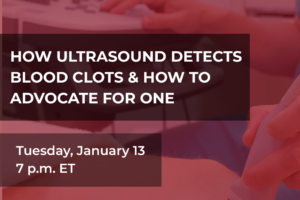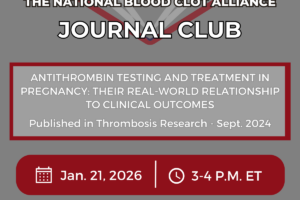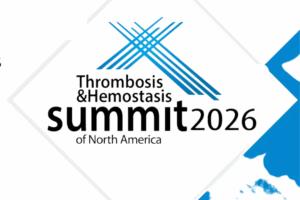Antithrombin Deficiency
An In-Depth Guide for Patients and Healthcare Providers
By Stephan Moll, MD
Last reviewed on July 22, 2024 by Dana Angelini, MD
What is Antithrombin?
Antithrombin is a protein in our blood, which functions as a naturally occurring anticoagulant. It is like a police protein that prevents us from clotting too much. It blocks our blood clotting mechanism by inactivating the major clotting protein “thrombin.” It is, therefore, called “anti-thrombin.” While antithrombin III was the original name given to this protein, the correct name now is just antithrombin, with the “III” dropped. Common names and abbreviations for the same protein are antithrombin, antithrombin III, AT, ATIII, and heparin cofactor I.
Why is Antithrombin Important?
Antithrombin protects us from clotting too much. If antithrombin levels are low, a person will have a tendency to clot more easily. If antithrombin levels are too high, a person could, theoretically, have a bleeding tendency. However, elevated levels of antithrombin do not appear to cause bleeding or have any clinical significance.
How are Antithrombin Levels Measured?
The best test to determine whether a patient has antithrombin deficiency is a blood test called “antithrombin activity” or “functional antithrombin.” Any physician’s office can order the antithrombin tests and many laboratories can perform them. Two different antithrombin tests can be done: (a) an antithrombin antigen level and (b) an antithrombin activity level (also called “functional test”).
The antithrombin antigen test determines how much of the protein is present in the blood. The antithrombin activity test determines whether the antithrombin that is present actually works. There are two main types of antithrombin deficiency (AT deficiency), depending on which of these two tests results is low. They are referred to as “type 1” and “type 2” deficiency.
Activity and antigen levels are typically expressed as a percentage. Normal ranges differ from lab to lab, but are typically 80 to 120%. Healthy newborns have only half the antithrombin levels of adults, but gradually reach the adult levels by 6 months of age. This is important to keep in mind when interpreting the tests of newborn children.
Being on birth control pills, hormone replacement therapy, or being pregnant does not change antithrombin test results significantly. However, being on warfarin (sold under brand names Coumadin and Jantoven) can increase antithrombin levels.
A normal level while a person is on warfarin does not rule out the presence of AT deficiency. Once a patient is off warfarin, the antithrombin activity test should be repeated. In addition, antithrombin levels can be low in other conditions, such as in the setting of a recent blood clot, having liver disease, or when testing is done while on blood thinners such as unfractionated heparin or enoxaparin (sold under the brand name Lovenox).
There are many different mutations in the antithrombin gene that can lead to inherited antithrombin deficiency or a functional problem of the protein. This means genetic testing is not possible in routine clinical practice. Rather, it’s reserved for research studies. Patients with inherited antithrombin deficiency typically have levels in the 40 to 60% range. It is not well established whether the degree of AT decrease correlates with the risk of thrombosis. This means it’s not clear whether patients with lower values have a higher risk for thrombosis.
Antithrombin Deficiency
Inherited antithrombin deficiency increases the risk for blood clots. Acquired AT deficiency often does not. There are two major causes of AT deficiency: (a) an inherited deficiency due to a genetic abnormality or mutation, and (b) an acquired deficiency due to some other disease (see table, numbers 1-3).
There are also several conditions under which a person temporarily has low antithrombin levels (see table, numbers 4-8), but levels return to normal once the condition has resolved. If antithrombin levels are measured at the time of an acute clot or while the patient is on heparin, levels may be temporarily low. However, they typically return to normal once the patient has recovered from the acute clot (within a few days to weeks) or when heparin is discontinued.
This is important to know to avoid a wrong diagnosis of AT deficiency if low values are found. A definitive diagnosis of hereditary deficiency is sometimes difficult to make because of these interfering causes. Repeat testing at a later time to confirm a low level is always advisable to make a definitive diagnosis. Sometimes, family testing is necessary to help clarify the diagnosis of inherited versus acquired deficiency.
Practical advice for any patient who carries the diagnosis of AT deficiency is to question the diagnosis and make sure it was not based on a low level obtained at the time of an acute clot. Sometimes, AT levels increase when a person is on warfarin. This means normal levels during warfarin therapy do not reliably rule out AT deficiency. Rechecking a level once a patient is off warfarin is appropriate.
Inherited Antithrombin Deficiency
Inherited AT deficiency is equally common in men and women. A person’s risk for blood clots depends on a number of factors, such as the degree and type of deficiency, family history of clots, and other risk factors (pregnancy or estrogen therapy, surgery, immobility, obesity, active cancer, smoking and others). Inherited AT deficiency is an uncommon genetic disorder. It occurs in 0.02 % of the general population, or 1 out of 5,000 people has it. There are approximately 66,200 people in the U.S. that have this mutation. However, this is an estimate.
It is inherited in a dominant pattern, which means there is a 50 % chance that a child will have the disorder if one of the parents has it. Men and women are equally affected. It is independent of blood types. If a person has inherited one defective (mutated) antithrombin gene, they are heterozygous. If an individual has inherited two defective (mutated) genes, they are homozygous. Homozygous individuals rarely survive and the fetus usually dies before birth, resulting in a miscarriage. A classification of “type I” and “type II” deficiency distinguishes the different types of hereditary AT deficiency.
Type I Deficiency
If an individual does not produce enough antithrombin, antigen and activity levels are both low. This is called type 1 deficiency, or a quantitative deficiency. It is either due to an inherited gene defect, or due to an acquired problem, where less antithrombin is made in the liver (such as in liver cirrhosis) or antithrombin is lost in the urine (as may happen in certain kidney diseases).
Type II Deficiency
This may be the least severe of all antithrombin deficiencies. Some people produce normal amounts of antithrombin protein, but the protein has an abnormal structure and does not work right. This is called type II deficiency. It is due to an inherited defect (mutation). In this type of deficiency, the antigen level is normal, but the activity level is low. A normal antithrombin antigen level never fully rules out an AT deficiency. To fully rule out AT deficiency, one always needs to obtain an antithrombin activity level. The antithrombin activity level is the best initial test to obtain if one suspects that a patient may have AT deficiency.
The type II defects are further subclassified into type IIa, IIb, and IIc defects, based on the location of the defect in the antithrombin molecule. The conventional wisdom is that it does not matter for clinical management purposes what type of deficiency a person with AT deficiency has. However, there is a subtype of type II deficiency called type IIb, which is the most common type of antithrombin deficiency. It is caused by an abnormality in the heparin-binding region of the antithrombin molecule.
Interestingly, it is associated with only a very low risk for blood clots. Most clinicians do not order specialized testing to clarify exactly what type of antithrombin deficiency a patient has, but it may be important. An individual who has been found to have antithrombin deficiency but has never had a clot may want to know whether they have type IIb or one of the other types. If they have type IIb, they would have to worry less about the future risk for blood clots.
People with AT deficiency are at increased risk for blood clots in veins, such as clots in the veins of the leg (called deep vein thrombosis or DVT) and clots in the lung (called pulmonary embolism or PE). Other venous clots may also occur, particularly in the arm (upper extremity DVT), intestinal tract (portal vein thrombosis, Budd-Chiari syndrome, etc.), or around the brain (sinus or cerebral vein thrombosis).
The risk to develop clots in the veins can be quite high, but this can vary from family to family. This variation depends on where in the antithrombin protein the inherited abnormality is. Some is due to the presence or absence of other clotting disorders and some of this variation is not well understood. In general, approximately 50% of individuals with AT deficiency will develop a blood clot during their life. A significant number of individuals develop clots before they are 30 years old. However, quite a few people also reach old age without ever developing a clot. As discussed earlier, having the type IIb antithrombin deficiency may not be all that much of a risk factor for blood clots. AT deficiency does not appear to be a risk factor for clots in arteries (strokes or heart attacks).
Many physicians will recommend that an individual with true AT deficiency who has had a blood clot should be on indefinite blood thinner therapy. If a person has AT deficiency but has never had a blood clot, it is difficult to decide whether to start long-term blood thinner therapy or not. In this case, other factors need to be considered: does the person have additional risk factors for blood clots, such as obesity, smoking, a sedentary lifestyle, presence of an additional clotting disorder or a family history of blood clots? Also, the degree of AT deficiency should be factored in, as should the type of deficiency. Clearly, an individual decision needs to be made whether the person should be on long-term blood thinners or not.
For oral blood thinner options, both warfarin (sold under brand names Coumadin and Jantoven) and the class of medication termed direct oral anticoagulant (DOAC) such as rivaroxaban (sold under brand name Xarelto) or apixaban (sold under brand name Eliquis) are options, but ultimately the choice of long term blood thinner needs to be individualized.
Acquired Antithrombin Deficiency
Acquired AT deficiency is not uncommon. Low levels of antithrombin can be found in patients with the conditions listed in the table below. Typically, acquired AT deficiency does not lead to an increased risk of blood clots. This is because in these conditions, clotting factors other than antithrombin are frequently also lowered.
Causes of Acquired Antithrombin Deficiency
- Liver failure (such as liver cirrhosis)
- Nephrotic syndrome (a kidney disorder)
- Widespread (metastatic) tumors
- Acute blood clots
- Heparin therapy
- Disseminated intravascular coagulation, a generalized clotting and bleeding disorder that is often associated with infection in the blood stream, or sepsis.
- Severe trauma
- Severe burns
- Chemotherapy with asparaginase
Antithrombin Concentrates
A person with AT deficiency may be given intravenous AT concentrates at times of increased risk for blood clots, including surgery and childbirth. AT concentrates may also be given when blood thinners are not a safe option because of an increased risk for bleeding. It is not well established which individuals with AT deficiency need to receive concentrates and which ones do not. No guidelines exist as to which patients with AT deficiency should receive antithrombin concentrate. Typically, treatment is given only at times of increased risk for clotting, or when the blood thinner heparin cannot be safely given because it would lead to an increased risk for bleeding. These situations are major surgery, major trauma, and childbirth. Two types of antithrombin preparations (drugs) are available in the U.S.:
1. Human plasma-derived antithrombin (Thrombate III in the U.S. by Grifols; several other products in the rest of the world). This is a highly purified, human, blood-derived antithrombin protein concentrate. It is prepared from the blood of tens of thousands of donors, similar to the preparation of clotting factor VIII for hemophilia patients. The blood of each individual donor is screened for hepatitis, HIV, and other viruses, such as parvovirus B-19. The part of the blood called plasma is then highly purified, resulting in an antithrombin concentrate. Any potentially contaminating viruses are killed using one or more different methods, such as heat inactivation or special filtration techniques.
2. ATryn by EVO Biologics is a recombinant antithrombin product that is FDA approved in the U.S. for preventing thromboembolic events in patients with hereditary antithrombin deficiency during surgery or during childbirth. To make this product, the human antithrombin gene has been inserted into the living cells of goats so that they produce high concentrations of human antithrombin in their milk. The milk is then purified and the antithrombin concentrated. Goats are bred and kept on a security-protected specialized goat farm and are regularly monitored by veterinarians for their health. Similarly, the antithrombin derived from their milk is tested regularly for its safety. ATryn was FDA approved in the U.S. in March 2009 and is available for clinical use.
Heparin Resistance
In some patients with AT deficiency who need heparin therapy, antithrombin concentrate may have to be given so that heparin can work optimally. Heparin (including the low molecular weight heparins, such as Fragmin, Innohep, Lovenox, etc.) may not thin the blood optimally if an individual has low antithrombin levels. This is because heparin’s effect depends on the presence of antithrombin. In such cases, higher than normal heparin doses may need to be given to reach full protection against blood clots. In some circumstances, a patient can be “heparin resistant” and will not respond effectively to heparin at all – even at higher doses. In these situations, treatment with intravenous antithrombin concentrates can be considered.
Antithrombin Deficiency in Children
Parents of children with AT deficiency need to be aware of the symptoms of blood clots. Blood clots are uncommon in children with AT deficiency, probably because another naturally occurring blood thinner (α2-macroglobulin) is higher during the first two decades of life, protecting most children from blood clots. However, there have been several reports of clots occurring in newborns with AT deficiency. Discussion between the expectant parents, of whom one parent has AT deficiency, and the hematologist (“blood doctor”) and perinatologist (a physician who deals with complications or high risk before or after birth) should be held prior to delivery. Parents need to be aware of the symptoms of blood clots should they occur in their baby.
Most newborn infants with AT deficiency do not need preventive treatment with heparin or AT concentrate, but may benefit from particularly careful attention to hydration and their kidney and circulatory function. Most children with AT deficiency do not develop blood clots unless there is an additional triggering event, such as surgery, trauma, a catheter, or severe infection. Children known to have AT deficiency may receive preventive therapy with blood thinners around trigger events.
Children with underlying medical conditions that cause acquired antithrombin deficiency, such as nephrotic syndrome (a kidney disorder), protein losing enteropathy (an intestinal disorder) and L-asparaginase chemotherapy for leukemia, have an increased risk of thrombosis. Although it is not clear how much of the thrombotic risk is actually caused by AT deficiency, children who develop clots with such acquired AT deficiency may benefit from antithrombin concentrate to treat the acute clot, and may benefit from blood thinning therapies (including antithrombin) to prevent further blood clots.
Antithrombin Deficiency and Pregnancy
Women with AT deficiency are at particularly high risk for developing clots during pregnancy and after delivery. The exact risk of developing blood clots during pregnancy is impossible to determine accurately. One study showed that only 3 % of pregnancies will be complicated by a blood clot if no concomitant prophylactic blood thinners are given. However, other studies have shown that blood clots occur in up to 50 % of pregnancies. Treatment with heparin injections underneath the skin (subcutaneously) during pregnancy should strongly be considered to prevent blood clots.
However, no well-designed clinical studies exist that allow strong recommendations as to how exactly to treat pregnant women (dose of heparin; treatment with antithrombin concentrate, etc.). Some physicians recommend antithrombin replacement therapy during delivery, when heparin may be contraindicated, since heparin might lead to an increased risk of bleeding. AT concentrate may also be given for a few days after delivery, together with heparin. Warfarin is not used in early pregnancy because it may cause birth defects.
For women who are 6-12 weeks postpartum, blood thinners should be considered because there is a high risk for blood clots in the post-delivery period. There are published reports of treating pregnant women who have antithrombin deficiency with antithrombin concentrate along with blood thinners. There are several international guideline recommendations for the use of blood thinners to prevent blood clots in someone who is pregnant with history of antithrombin deficiency, but the recommendation on blood thinner dose, monitoring of blood thinner, and use of antithrombin concentrate varies among the guidelines due to the lack of good quality data to inform these recommendations.
Women with AT deficiency also have an increased risk for pregnancy loss, either early (miscarriage) or late (stillbirth) in the pregnancy. This is probably due to blood clots forming in the placenta, leading to blockage of blood flow and oxygen delivery to the fetus. Approximately 1 out of 6 pregnancies (17%) in women with antithrombin deficiency will end with an early fetal loss, and 1 in 40 pregnancies (2.3 %) will end with a stillbirth if no blood thinners are given. Therapy with heparin with or without antithrombin throughout the pregnancy likely decreases that risk.
Antithrombin Deficiency and Surgery or Trauma
Individuals with AT deficiency need very good DVT prophylaxis with blood thinners at times of surgery or major trauma. Treatment with antithrombin concentrate during these times can also be considered. Major surgery and trauma are risk factors for blood clots (deep vein thrombosis or pulmonary embolism) in anybody, but they are an even greater risk for the person with AT deficiency. Extra attention to DVT prophylaxis is therefore indicated, typically with one of the heparin drugs.
If trauma or excessive risk for bleeding (neurosurgery, for example) does not allow physicians to give the blood thinner, antithrombin concentrate is recommended. Also, placement of a removable filter into the inferior vena cava, the big vein of the abdomen, may be considered on a case by case basis. Such a filter can capture blood clots that have formed in the leg and are traveling upstream on their way to the lung, preventing a life-threatening pulmonary embolism. Antithrombin concentrate may be given for the first few days after surgery. Depending on the type and extent of the surgery, prolonged use of blood thinners for several weeks after surgery may be appropriate.
Family Testing
Other family members should consider getting tested. If a person has been diagnosed with AT deficiency and has none of the acquired factors or disorders that cause acquired AT deficiency (see table), an inherited AT deficiency may be present. It is then appropriate to inform other family members (children, parents, uncles and aunts) of the diagnosis. These family members should seriously consider getting tested, and an antithrombin activity test should be done.
Practical Issues
Making a correct diagnosis of inherited AT deficiency can be challenging. Treatment decisions, including consideration of initiation of blood thinner therapy in a person who has never had a blood clot; length of therapy with blood thinners in the person who has had a blood clot; and pregnancy management, can be difficult. It is important to work with a knowledgeable healthcare provider. Hematologists, preferably associated with a thrombosis or thrombophilia center, often have the most experience dealing with clotting disorders, such as antithrombin deficiency.
Key Issues
- If you have been diagnosed with antithrombin deficiency, question the diagnosis. Be aware that misdiagnosis may occur if the timing of testing and interpretation of the result was incorrect.
- Be sure you ask your doctor whether you have an acquired deficiency (not relevant for other family members) or an inherited deficiency (other family members should consider getting tested).
- If you have inherited AT deficiency, consider being evaluated by a thrombosis specialist (typically a hematologist) at a specialized thrombosis center.
- Know the symptoms of blood clots in the legs (deep vein thrombosis or DVT: swelling, usually in one leg; leg pain or tenderness; reddish or bluish skin discoloration; leg that’s warm to the touch) or lung (pulmonary embolism or PE: sudden shortness of breath; sharp and stabbing chest pain that may get worse with deep breaths; rapid heart rate; unexplained cough, sometimes with bloody mucus) and make lifestyle changes (lose weight, stop smoking, consider stopping estrogen therapy, such as the birth control pill, patch or ring and hormone replacement therapy).
- If you have inherited AT deficiency, make sure you get very good DVT prophylaxis in risk situations (surgery, major trauma, prolonged immobility, pregnancy).
Selected References
- “Inherited Antithrombin Deficiency: a Review”. Patnaik M, Moll S. Haemophilia 2008;14:1229-1239.
- “Thrombosis in Antithrombin-III-Deficient Persons”. Demers C et al. Ann Intern Med 1992;116:754-761.
- “Increased fetal loss in women with heritable thrombophilia”. Preston FE et al. Lancet 1996; 348:913-916.
- “Management of pregnancy with congenital antithrombin III deficiency: two case reports and a review of the literature”. Yamada T. J Obstet Gynaecol Res 2001; 27:189-197.
- http://www.gtc-bio.com/news/atryn%C2%AE-antithrombin-recombinant-approved-fda
- Management of Hereditary Antithrombin Deficiency in Pregnancy. Thromb Res. 2017 Sep:157:41-45.
Abbreviations used:
- AT deficiency: Antithrombin deficiency
- DVT: Deep vein thrombosis, or a blood clot in the deep veins of legs, arms, abdomen, or around the brain.
- PE: Pulmonary embolism, or a a blood clot in the lung.
Author:
Stephan Moll, MD. Department of Medicine, Division of Hematology-Oncology, University of North Carolina School of Medicine, Chapel Hill, NC.
Acknowledgement:
Review of manuscript: Elizabeth Varga, Columbus, OH; Dr. Marilyn Manco-Johnson, Denver, CO; Dr. Kenneth Bauer, Boston, MA; 2 individuals with inherited antithrombin deficiency. Layout and graphic design: Jeff Harrison, Wilmington, NC.
Disclaimer:
The National Blood Clot Alliance (NBCA) and its Medical and Scientific Advisory Board (MASAB) do not endorse or recommend any commercial products, processes, or services. The views and opinions of authors expressed on the NBCA or MASAB websites or in NBCA or MASAB written materials do not necessarily state or reflect those of NBCA or MASAB, and they may not be used for advertising or product endorsement purposes. It is not the intention of NBCA or MASAB to provide specific medical advice, but rather to provide users with information to better understand their health and their diagnosed disorders. Specific medical advice will not be provided and both NBCA and MASAB urge you to consult with a qualified physician for diagnosis and for answers to your personal questions.






